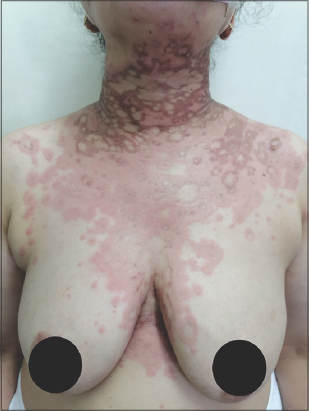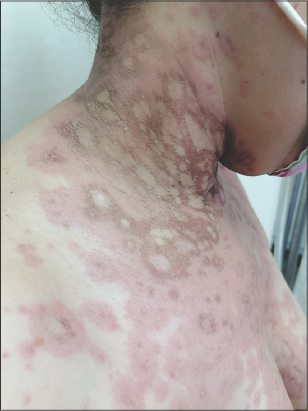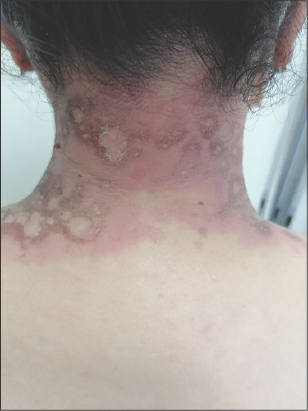Contact urticaria with a chemical burn caused by a hydroalcoholic gel with chlorhexidine
Asmae Abdelmouttalib , Hasna Azendour, Sanae Sialiti, Mariame Meziane
, Hasna Azendour, Sanae Sialiti, Mariame Meziane
Dermatology and Venereology Department, Mohamed V University in Rabat, Morocco
Corresponding author: Asmae Abdelmouttalib, MD
How to cite this article: Abdelmouttalib A, Azendour H, Sialiti S, Meziane M. Contact urticaria with a chemical burn caused by a hydroalcoholic gel with chlorhexidine. Our Dermatol Online. 2021;12(3):326-327.
Submission: 21.01.2021; Acceptance: 05.04.2021
DOI: 10.7241/ourd.20213.23
Citation tools:
Copyright information
© Our Dermatology Online 2021. No commercial re-use. See rights and permissions. Published by Our Dermatology Online.
Chlorhexidine is used as an antiseptic and disinfectant agent because of its wide antimicrobial spectrum. Immediate hypersensitivity reactions to chlorhexidine have rarely been reported in the literature [1]. One case of contact urticaria caused by chlorhexidine has been reported following dermal exposure to a hydroalcoholic gel.
A 45-year-old female with obsessive–compulsive disorder presented with an acute itchy eruption on the neck and cleavage, which appeared five days earlier, ten minutes after the frictional application of a hydroalcoholic gel to prevent a COVID-19 infection. The patient presented urticarial lesions with annular erythematous wheals on the neck and cleavage and extending to the submammary area. Brownish scales were also present, indicating the beginning of skin healing after the chemical burn (Figs. 1–3). There were neither angioedema nor respiratory symptoms. She reported a similar eruption located initially on the hands and forearms after the first application of the hydroalcoholic gel, which resolved spontaneously in several hours. She had never used any product containing chlorhexidine before and had no history of allergic reactions. Contact urticaria to the hydroalcoholic gel was suspected. The patient was treated with cetirizine at a dose of 10 mg once daily and scar creams, with a rapid resolution of the skin lesions.
Consent
The examination of the patient was conducted according to the principles of the Declaration of Helsinki.
The authors certify that they have obtained all appropriate patient consent forms, in which the patients gave their consent for images and other clinical information to be included in the journal. The patients understand that their names and initials will not be published and due effort will be made to conceal their identity, but that anonymity cannot be guaranteed.
REFERENCES
1. Gupta H, Gupta M. Dermatological manifestations in the intensive care unit –A prospective study. Our Dermatol Online. 2018;9:390-2.
Notes
Source of Support: Nil,
Conflict of Interest: None declared.
Request permissions
If you wish to reuse any or all of this article please use the e-mail (brzezoo77@yahoo.com) to contact with publisher.
| Related Articles | Search Authors in |
|
|






Comments are closed.